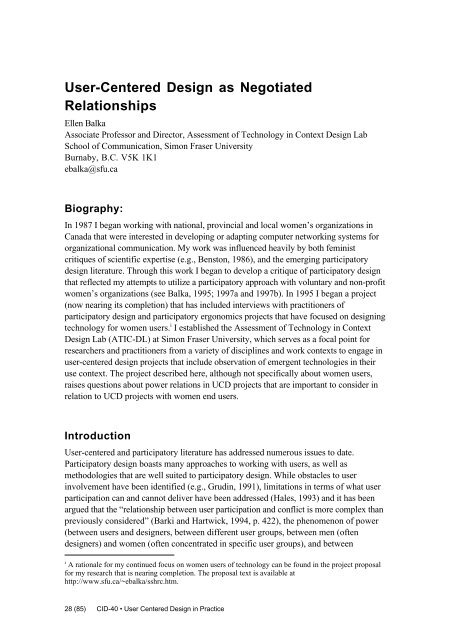User Centered Design in Practice - Problems and Possibilities
User Centered Design in Practice - Problems and Possibilities
User Centered Design in Practice - Problems and Possibilities
You also want an ePaper? Increase the reach of your titles
YUMPU automatically turns print PDFs into web optimized ePapers that Google loves.
<strong>User</strong>-<strong>Centered</strong> <strong>Design</strong> as Negotiated<br />
Relationships<br />
Ellen Balka<br />
Associate Professor <strong>and</strong> Director, Assessment of Technology <strong>in</strong> Context <strong>Design</strong> Lab<br />
School of Communication, Simon Fraser University<br />
Burnaby, B.C. V5K 1K1<br />
ebalka@sfu.ca<br />
Biography:<br />
In 1987 I began work<strong>in</strong>g with national, prov<strong>in</strong>cial <strong>and</strong> local women’s organizations <strong>in</strong><br />
Canada that were <strong>in</strong>terested <strong>in</strong> develop<strong>in</strong>g or adapt<strong>in</strong>g computer network<strong>in</strong>g systems for<br />
organizational communication. My work was <strong>in</strong>fluenced heavily by both fem<strong>in</strong>ist<br />
critiques of scientific expertise (e.g., Benston, 1986), <strong>and</strong> the emerg<strong>in</strong>g participatory<br />
design literature. Through this work I began to develop a critique of participatory design<br />
that reflected my attempts to utilize a participatory approach with voluntary <strong>and</strong> non-profit<br />
women’s organizations (see Balka, 1995; 1997a <strong>and</strong> 1997b). In 1995 I began a project<br />
(now near<strong>in</strong>g its completion) that has <strong>in</strong>cluded <strong>in</strong>terviews with practitioners of<br />
participatory design <strong>and</strong> participatory ergonomics projects that have focused on design<strong>in</strong>g<br />
technology for women users. i I established the Assessment of Technology <strong>in</strong> Context<br />
<strong>Design</strong> Lab (ATIC-DL) at Simon Fraser University, which serves as a focal po<strong>in</strong>t for<br />
researchers <strong>and</strong> practitioners from a variety of discipl<strong>in</strong>es <strong>and</strong> work contexts to engage <strong>in</strong><br />
user-centered design projects that <strong>in</strong>clude observation of emergent technologies <strong>in</strong> their<br />
use context. The project described here, although not specifically about women users,<br />
raises questions about power relations <strong>in</strong> UCD projects that are important to consider <strong>in</strong><br />
relation to UCD projects with women end users.<br />
Introduction<br />
<strong>User</strong>-centered <strong>and</strong> participatory literature has addressed numerous issues to date.<br />
Participatory design boasts many approaches to work<strong>in</strong>g with users, as well as<br />
methodologies that are well suited to participatory design. While obstacles to user<br />
<strong>in</strong>volvement have been identified (e.g., Grud<strong>in</strong>, 1991), limitations <strong>in</strong> terms of what user<br />
participation can <strong>and</strong> cannot deliver have been addressed (Hales, 1993) <strong>and</strong> it has been<br />
argued that the “relationship between user participation <strong>and</strong> conflict is more complex than<br />
previously considered” (Barki <strong>and</strong> Hartwick, 1994, p. 422), the phenomenon of power<br />
(between users <strong>and</strong> designers, between different user groups, between men (often<br />
designers) <strong>and</strong> women (often concentrated <strong>in</strong> specific user groups), <strong>and</strong> between<br />
i A rationale for my cont<strong>in</strong>ued focus on women users of technology can be found <strong>in</strong> the project proposal<br />
for my research that is near<strong>in</strong>g completion. The proposal text is available at<br />
http://www.sfu.ca/~ebalka/sshrc.htm.<br />
28 (85) CID-40 • <strong>User</strong> <strong>Centered</strong> <strong>Design</strong> <strong>in</strong> <strong>Practice</strong>

















